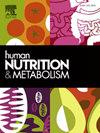叶酸和(6S)-5-甲基四氢叶酸生物利用度对婴儿红细胞叶酸基线浓度的依赖性
IF 1.8
Q3 ENDOCRINOLOGY & METABOLISM
引用次数: 0
摘要
叶酸的生物利用度可能取决于个体的叶酸状态和食物中叶酸的形式。目的研究叶酸或(6S)-5-甲基四氢叶酸(5-MTHF-Ca)钙盐饮食干预后红细胞叶酸浓度的变化是否依赖于基线红细胞叶酸,并因叶酸形式不同而不同。方法我们研究了167名婴儿,从1个月大(基线访问)到16周大(访问4),随机选择每100千卡含有15.2 μg叶酸或15.8 μg 5-MTHF-Ca的婴儿配方奶粉。使用广义加性模型(GAMs)来研究基线访问和第4次访问(研究结果)之间红细胞叶酸浓度的变化是否取决于干预措施(叶酸或5-MTHF-Ca)、干预时间长短以及每个干预组的基线红细胞叶酸浓度的平滑效果。结果GAM基础模型显示,基线红细胞叶酸浓度较低的婴儿红细胞叶酸变化较大。这个模型解释了数据中42%的偏差。对于服用叶酸的那一组,这种影响估计是线性的(有效自由度= 1)。在接受5-MTHF-Ca治疗的组中,基线红细胞叶酸对红细胞叶酸变化的影响是非线性的。基线红细胞叶酸对红细胞叶酸浓度变化的平滑效应在干预组之间存在差异(p = 0.002)。在基线红细胞叶酸浓度较高的婴儿中,5-MTHF-Ca组红细胞叶酸浓度的变化系统性高于叶酸组。结论基线红细胞叶酸水平高时,叶酸和5-MTHF-Ca的生物利用度呈生理性下降。摄入叶酸后,生物利用度的降低更为明显。研究结果可能会影响婴儿对不同叶酸形式的摄入量建议。这些结果背后的分子机制值得进一步研究。本文章由计算机程序翻译,如有差异,请以英文原文为准。
Dependence of bioavailability of folic acid and (6S)-5-methyltetrahydrofolate on baseline red blood cell folate concentrations in infants
Background
Folate bioavailability may depend on folate status of an individual and the form of folate presents in foods.
Objective
We studied whether changes of red blood cell (RBC)-folate concentrations following dietary intervention with folic acid or the calcium salt of (6S)-5-methyltetrahydrofolate (5-MTHF-Ca) depend on baseline RBC-folate and differ by the folate form provided.
Methods
We studied 167 infants randomized to infant formula with either 15.2 μg folic acid or 15.8 μg 5-MTHF-Ca per 100 kcal from <1 month of age (baseline visit) until age 16 weeks (visit 4). Generalised Additive Models (GAMs) were used to study whether the changes in RBC-folate concentrations between baseline visit and visit 4 (study outcome) depend on the intervention (folic acid or 5-MTHF-Ca), length of the intervention and a smooth effect of baseline RBC-folate concentrations for each intervention group.
Results
The GAM base model showed that the change of RBC-folate was higher in infants with lower baseline RBC-folate concentrations. This model explained 42 % of the deviance in the data. For the group that received folic acid, this effect was estimated to be linear (effective degrees of freedom = 1). In the group receiving 5-MTHF-Ca, the effect of baseline RBC-folate on the change of RBC-folate was non-linear. The smooth effect of baseline RBC-folate on the change of RBC-folate concentrations differed between the intervention groups (p = 0.002). In infants with higher baseline RBC-folate concentrations, the change of RBC-folate concentration is systematically higher in the 5-MTHF-Ca group than in the folic acid group.
Conclusion
The bioavailability of folic acid and 5-MTHF-Ca shows physiological decline when baseline RBC-folate is high. The reduction of the bioavailability is more pronounced after folic acid intake. The results may impact infant's intake recommendations from different folate forms. The molecular mechanisms behind these results deserve further investigations.
求助全文
通过发布文献求助,成功后即可免费获取论文全文。
去求助
来源期刊

Human Nutrition and Metabolism
Agricultural and Biological Sciences-Food Science
CiteScore
1.50
自引率
0.00%
发文量
30
审稿时长
188 days
 求助内容:
求助内容: 应助结果提醒方式:
应助结果提醒方式:


